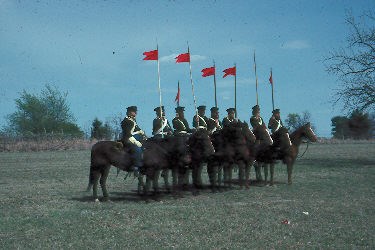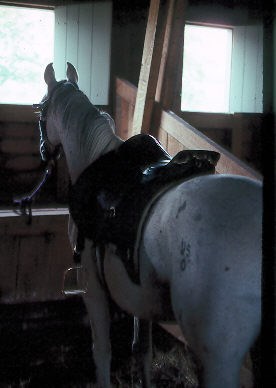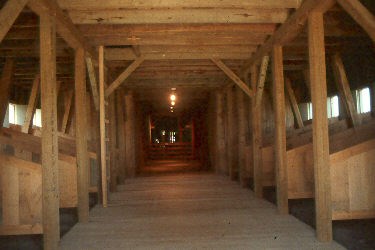
The First Regiment of United States Dragoons (horse soldiers) was established by an Act of Congress on March 2, 1833, and was authorized to contain 10 companies of soldiers. Between 1842 and 1853 Company A, C, and F of the First Dragoons were periodically stationed at Fort Scott and averaged approximately 60 soldiers and horses per company. Each company had a designated color for its horses, which were: A and K, black; B, F, and H, sorrel; C, D, E and I, bay; and G, iron gray. The uniform color of the horses enabled individual companies to be identified from a distance and new remounts (replacements) to be accepted more quickly by the other horses. 
A company officer selected the dragoon horses from the open livestock market and they were paid for by the Quartermaster Department. If no horses were available locally, the company officer and a noncommissioned officer would be assigned to Remount Duty and would travel to the nearest city to select the specified number of horses. During the 1840s the Quartermaster Department at Fort Scott paid between $50 and $60 apiece for "warranted sound horses." Potential dragoon horses were inspected before they were selected and they were required to be sound (not lame), free from injuries, trained to ride, able to travel at all gaits (walk, trot, canter, and gallop), and have a good disposition. The most desirable horses were between five and nine years of age and from 15 to 16 hands (60-64 inches) high. The dragoons used all kinds of riding horses which were from many different breeds. Horses with mixed breeding were normally cheaper, but the officers often purchased purebred horses with their own money for their personal use. Once in the stables, each animal was assigned his stall by platoon. When the practice began is not known, but in later times at least the names of the animals and their riders were placed over the stalls. Horses were tied to their stalls by lengths of rope that permitted the animals to lie down and get up with ease. These ropes were slightly less than the height above ground of the tie rung of the manger. 
The stables were not intended to keep the horses warm but to protect them from draft and inclement weather. Although no horse was allowed to be exposed to a draft, especially when sweating, ventilation was important; and the windows were closed only in severe weather and then only on the windward side. Doors were left open whenever the stable was empty. All the floors had to be kept clean and were scrubbed with stable brooms and allowed to dry before fresh bedding was laid down. Bedding protected the horses from injury and by the animal lying down helped his legs to last longer. The preferred bedding was straw, free from moldiness or weeds. Sawdust from seasoned wood, shavings, and (in warm climates) peat moss also were also used. Once the horses were out of the stables, the bedding was shaken and sorted. Reusable bedding was aired on racks outside. In bad weather, the sorted straw was spread down the aisle or under the kicking bars, near the rear of the stalls. In the evening the dried bedding, mixed with fresh, was laid down with the thickest part away from the manger, so the horses would not eat it. The monthly allowance of hay was 100 pounds, which had to be conserved as much as possible. Inspectors who found a manure pile filled with good hay knew the officers had not been supervising the men properly. Earthen floors, such as Fort Scott had until 1848, were difficult to keep clean. To protect the horses' legs, wet depressions were filled with clay bound with ashes or crushed rock, well tamped. The dirt floor at the front of the stall for about two feet from the edge of the manger was leveled for the animals' front feet to rest on. Back of this, the floor declined to provide drainage. When floors had frozen water on them, they were sprinkled with sand or sifted ashes, before the bedding was put down. The same application was made in the aisles to prevent slipping. Hay racks and feed boxes were brushed out daily and cleaned at least once a month. In the twentieth Century, a solution of three tablespoons of lye in a bucket of warm water was used. The woodwork of the stable could be painted or unpainted; whitewash was not used. The latter when applied to mangers caused irritation to the eyes and when used elsewhere often rubbed off on the horses. All the woodwork in the stable had to be washed and kept clean. Stables were provided with buckets, barrels of water, and knives for cutting halter-tied ropes in case of fire. When the weather was zero or below, two and one-half pounds of salt could be added per gallon to water to prevent the fire barrels from freezing. Smoking in the stables was forbidden. The stable sergeants were responsible for the efficient care of the animals in the stables or picket lines on a march and all the attendant public property. They supervised the enlisted men on duty at the stables, had the safekeeping of the animals when they were not in use, took charge of the watering and feeding, cared for sick animals, received and issued the forage and bedding, were responsible for the police and minor repairs on the stables, and cared for the tools. Generally, the farrier*, a stable orderly, and the men on duty assisted them. All stables had rooms in which hay and grain were stored. To prevent theft, the doors were locked securely and where possible, iron gratings were placed over the windows. Either an officer or the stable Sergeant had to be present when troopers entered these rooms. Ventilation of the storerooms was of prime importance to prevent dampness. To permit adequate air circulation, the forage was piled on duckboards away from the walls, and spaces were left between the walls and ceilings to allow on airflow. When rodents got into a storeroom, traps were set but poisons were not permitted. The endless care of dragoon horses knew neither time nor climate: stable duty had to be performed daily. Drill was endless; but the dragoon made a brave appearance, and his image was captured by James Henry Carleton, who wrote of Fort Scott's Company A as it departed on the 1844 expedition from Fort Leavenworth: ... that is Capt. Terrett's troop of blacks; hardy, dashing looking fellows, those men, tanned up from their march from Fort Scott' from whence they have just joined us. . . . The men are nearly all quite young, and as a body are as handsome, athletic, vigorous, and soldierly looking as can be found in any service in the world . . . They are mounted on the best American horses, all of them upwards of fifteen hands in height. . . Prairie Logbooks, 1844-45 * The farrier was an individual who shod horses by nailing iron horseshoes to a horse's hooves. The information for this section was taken from the Historic Furnishing Report for The Dragoon Stables by Sally Johnson Ketchum. |
Last updated: July 25, 2016

